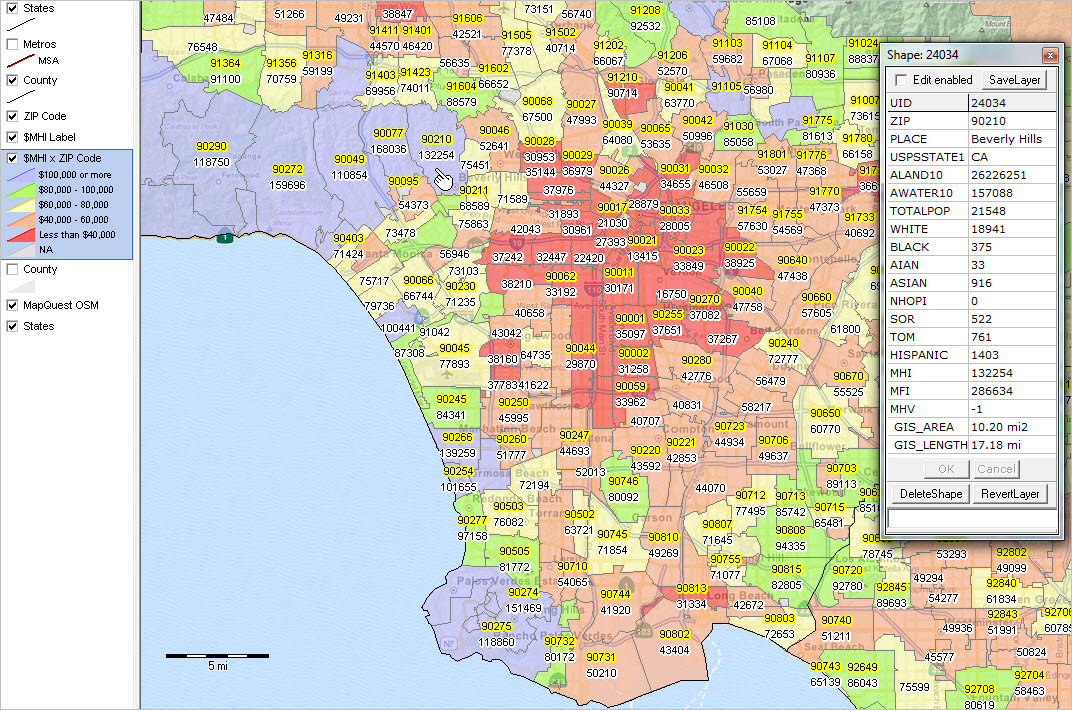

Geocoding is straightforward with geocode_OSM. addresses <- c("492 Old Connecticut Path, Framingham, MA", "250 Northern Ave., Boston, MA")
#Us zip code shapefile install
If you want to follow along, load each with pacman::p_load() or install any not yet on your system with install.packages(), then load each with library().įor this example, I’ll create a vector with two addresses, our IDG office in Framingham, Massachusetts, and the RStudio office in Boston. I’ll be using the sf, tmaptools, tmap, and dplyr packages. The tmaptools package has a function, geocode_OSM(), to use that API. To get around that bit of complexity for this article, I’ll use the free, open-source Open Street Map Nominatim API.
#Us zip code shapefile free
It’s free for 2,500 lookups a day and has a nice R package, but you need a (free) API key to use it.

Such calculations are often done with specialized GIS software. Files should not be used for determining precise geographic area relationships.ĭidn't find what you're looking for? Suggest a dataset here.Where do you vote? Who are you legislators? What is your ZIP code? These questions have something geospatially in common: The answer involves determining which polygon a point falls within. Files should not be used for geocoding addresses. Cartographic boundary files should not be used for geographic analysis including area or perimeter calculation.

The boundary information is for visual display at appropriate small scales only. These products are free to use in a product or publication, however acknowledgement must be given to the U.S.

This file should not be displayed at scales larger than 1:500,000. Access & Use InformationĪccess Constraints: None, Use Constraints:The intended display scale for this file is 1:500,000. The generalized ZCTA boundaries in this file are based on those delineated following the 2010 Census. Some ZIP Codes may not have a matching ZCTA because too few addresses were associated with the specific ZIP Code or the ZIP Code was not the most frequently occurring ZIP Code within any of the blocks where it exists. Because the Census Bureau only uses the most frequently occurring ZIP Code to assign blocks, a ZCTA may not exist for every USPS ZIP Code. These codes may contain leading zeros.īlocks that do not contain addresses but are surrounded by a single ZCTA (enclaves) are assigned to the surrounding ZCTA. The most frequently occurring ZIP Code also becomes the five-digit numeric code of the ZCTA. Tabulation blocks are assigned to a ZCTA based on the most frequently occurring ZIP Code for the addresses contained within that block. The Census Bureau uses tabulation blocks as the basis for defining each ZCTA. The USPS makes periodic changes to ZIP Codes to support more efficient mail delivery. Data users should not use ZCTAs to identify the official USPS ZIP Code for mail delivery. Virgin Islands once each decade following the decennial census. The Census Bureau delineates ZCTA boundaries for the United States, Puerto Rico, American Samoa, Guam, the Commonwealth of the Northern Mariana Islands, and the U.S. Postal Service (USPS) ZIP Code service areas that the Census Bureau creates to present statistical data for each decennial census. ZIP Code Tabulation Areas (ZCTAs) are approximate area representations of U.S. Some geographies are available as nation-based files while others are available only as state-based files. Geographic areas may not align with the same areas from another year. When possible, generalization is performed with the intent to maintain the hierarchical relationships among geographies and to maintain the alignment of geographies within a file set for a given year. These boundary files are specifically designed for small-scale thematic mapping. Census Bureau's Master Address File / Topologically Integrated Geographic Encoding and Referencing (MAF/TIGER) Database (MTDB). The 2019 cartographic boundary shapefiles are simplified representations of selected geographic areas from the U.S.


 0 kommentar(er)
0 kommentar(er)
